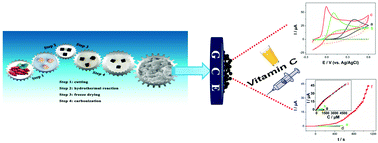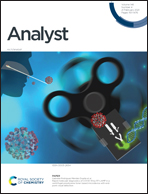Sweet potato derived three-dimensional carbon aerogels with a hierarchical meso–macroporous and branching nanostructure for electroanalysis†
Abstract
In this paper, sweet potatoes (Ipomoea batatas) are used as low-cost precursors to synthesize carbon aerogels with a hierarchical meso–macroporous and branching nanostructure (HMM-BNCA). An HMM-BNCA-modified glassy carbon electrode (GCE) (HMM-BNCA/GCE) exhibits high electrocatalytic activity for some electroactive biomolecules. For ascorbic acid (AA), the HMM-BNCA/GCE exhibits low oxidation peak potential and detection limit (−0.005 V and 0.45 μM, S/N = 3), high sensitivities (195.43 and 121.00 μA mM−1 cm−2) and wide linear ranges (10–1250 μM and 1250–4750 μM), which are superior to those obtained at the GCE and carbon nanotube (CNT)-modified GCE (CNT/GCE). The HMM-BNCA/GCE exhibits significant resistance to fouling and the interfering substances for the detection of AA. The successful and accurate detection of AA in real samples (such as vitamin C injections and vitamin C soft drinks) in this work demonstrates the feasibility and tremendous potential of HMM-BNCA/GCE for the analysis of AA in complex systems.

- This article is part of the themed collection: Analyst Recent HOT articles


 Please wait while we load your content...
Please wait while we load your content...